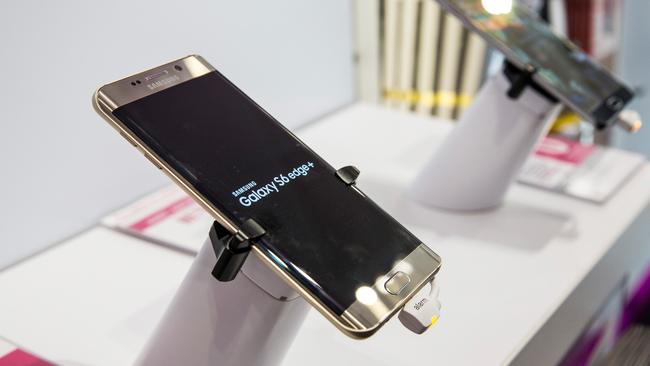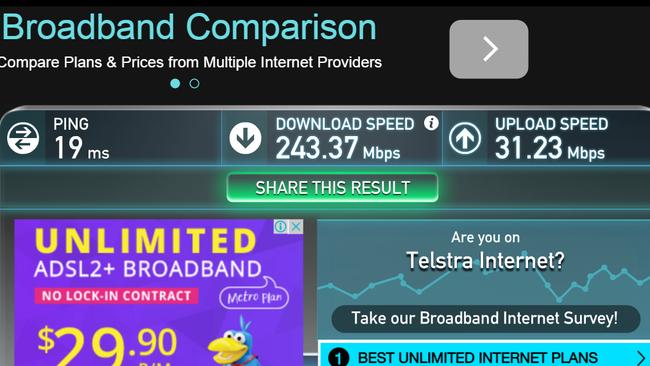Telstra Cat 9 network: for the magic you need all the pipelines
Testing a superfast 450Mbps data superhighway for phones sounds amazing but the reality doesn’t always match the hype.

Testing a superfast 450 megabit per second data superhighway for mobile phones can have its issues. It’s what I discovered when I tried Telstra’s new 4GX Cat 9 network with one of the first two phones designed to access it.
Last week’s local release of Samsung’s two new smartphone powerhouses, the Galaxy Note 5 and Galaxy S6 edge+ was extra significant for that reason.
So I obtained a Telstra-flashed Note 5, slotted in a Telstra SIM and began pounding the pavement in the neighbourhood of the News Corporation offices in Sydney. Telstra had armed me with information about where to for the best reception.
The first thing to note about the new Cat 9 is it’s not ubiquitous. Walking southward down Elizabeth Street past Devonshire Street towards Cleveland Street in Sydney, the phone’s ability to register a download speed of more than 100Mbps would wax and wane.
And in all the testing, I didn’t get near this quoted aspirational speed of 450Mbps.
Am I disappointed? Yes and no — yes as Telstra and Samsung had quoted it freely as the ballpark for 4GX Cat 9.
But it is very much an aspirational figure, it’s when one person is on the network late at night in a Cat 9 sweetspot, 4.5 times the common NBN fibre maximum. It’s a speed that would deliver you a full 4GB movie downloaded to your phone in the street in 71 seconds,
The reality was speeds well in excess of 100 megabits per second most of the time and even up to 247Mbps on one occasion. That’s using Ookla’s speedtest.net app downloaded to the Note 5. I connected to Telstra’s Sydney server in the app to ensure the speeds weren’t sabotaged by unrelated network issues.
Walking up Castlereagh Street from the Central Station direction, I achieved megabit per second rates of 142.16, 152.71, 108.11, 135.24, 127.64, 134.66, 169.56. 198.63, 133.19, 155.61 and 166.32. Like cellular networks generally, download rates would vary as I went along.
They’re affected too by the number of people in the CBD already connected to Telstra’s 4G network as the 4GX Cat 9 network isn’t a separate network; it’s an amalgam of three Telstra’s 4G spectra.
They are the 1800 MHz and 2600 MHz networks along with the 700 MHz spectrum Telstra bought at auction in 2013 for $1.3 billion. That figure includes a chunk of 2.5GHz spectrum as well. Optus also bought some 700 MHz spectrum.

The big download speeds occur when the phone accesses all three frequency ranges at once. You have three pipelines streaming data to your phone simultaneously. And there’s lots of phones using one or two of these pipelines already so even now, you’re not alone on Cat 9.
With the help of Telstra, we established that my phone was swapping from linking to one frequency range up to all three as we plodded along. And the main culprit was the 700 MHz spectrum which is far from everywhere. It’s early days for Cat 9 but Telstra plans to consolidate its 700 MHz offering to boost CBD capacity.
That also means Cat 9 is likely to be mostly a CBD affair where that high demand is needed. The service primarily targets business with Melbourne and Sydney the first two cities with others to follow.
I mightn’t have done the Cat 9 network justice by measuring speeds with smaller data packets used by the speedtest.net app. It takes time to throttle up to a maximum speed.
So we put the phone into modem mode and connected it to a Surface Pro tablet. We retested Cat 9 using speedtest.net in a browser where the throttling process is longer. That returned readings of 243.37/31.23Mbps and 209.33Mbps download/upload speeds. We didn’t get beyond that.
While I’m disappointed it’s not 450Mbps, 243.71 is a mighty advance on what we’re used to with mobile download. But you’ll need optimal conditions to get it.
Telstra will soon offer a Netgear cellular modem/router for those wanting to connect a small office of devices to it.
With such fast speeds, it’s more likely small businesses will want to install a modem and have several phones enjoying faster downloads rather than one operating at 250Mbps plus. In other words, they’ll share the love around.
Optus too will offer superfast 4G speeds. It’s available in three Newcastle suburbs where it conducted testing: Mayfield, Mayfield West and Lambton with Optus registering speeds on the Note 5 of up to 317Mbps.
It plans soon to offer it in Melbourne with Sydney online early next year and Brisbane and Adelaide coming after that.
Vodafone didn’t have information on hand about plans for faster 4G when we asked. However China communications technology firm Huawei which built 4G infrastructure for Optus and Vodafone says it’s planning towards building 5G networks in Australia.
Instead of 200-300Mbps, 5G networks potentially offer download speeds of 1 Gigabit per second and beyond, but it’s early days. Even the standards surrounding what exactly constitutes 5G are yet to be thrashed out, with implementation of this next generation technology not expected until around 2020.
A Huawei Australia spokesman said the company predicted a 50-fold improvement in responsiveness moving from 4G to 5G networks.
“Huawei Australia will soon make an announcement about a senior hire in 5G,” the spokesman said. “This hire will be driving Huawei Australia’s innovation and 5G efforts in our National Training and Innovation Centre.”
Huawei opened its $30 million national training centre in Australia last month.
Alas, speeds of 1Gbps were far from on the agenda as we traversed Sydney’s CBD with the Note 5.


